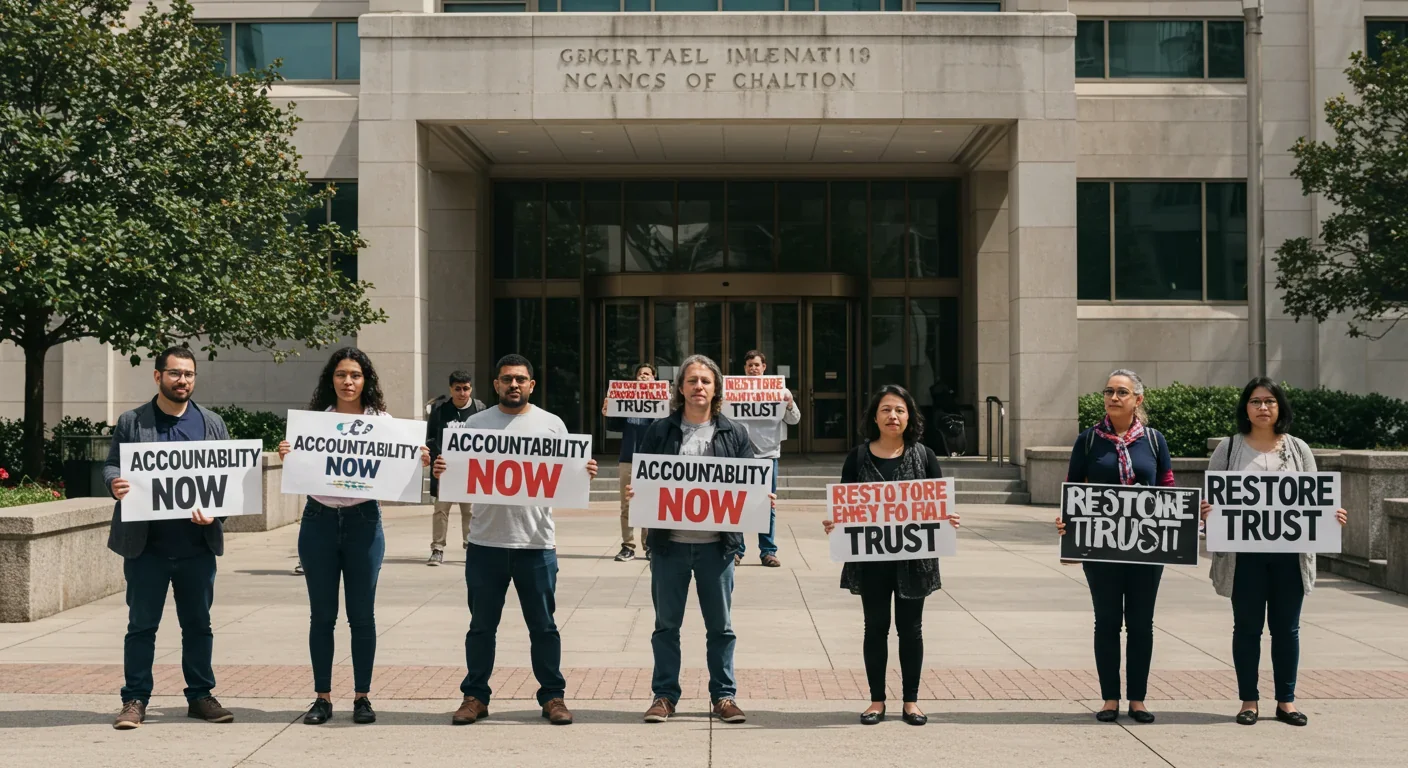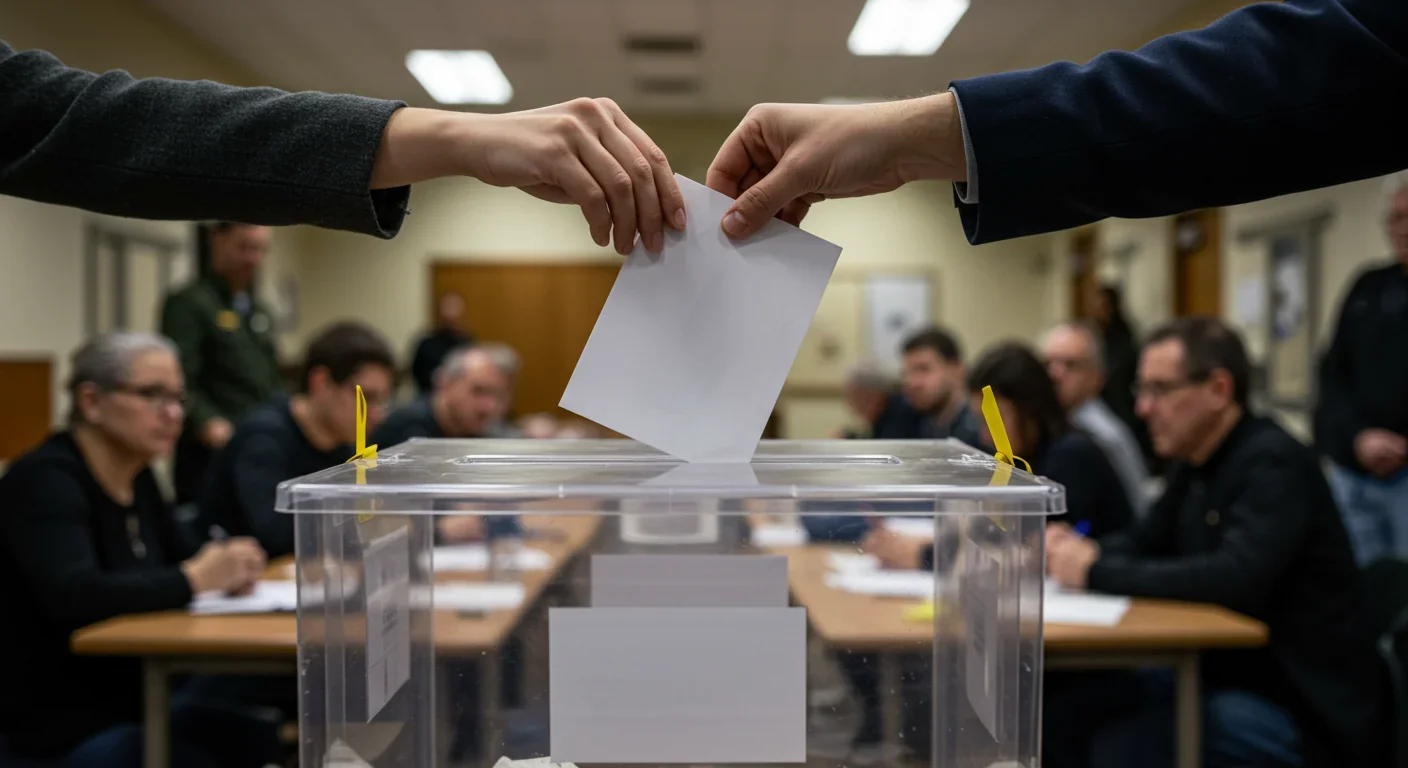Care Worker Crisis: Low Pay & Burnout Threaten Healthcare

TL;DR: Trust in government, finance, media, and corporations has collapsed over two decades, driven by scandals without consequences, political polarization, rapid tech change, and rising inequality. Yet global data reveals trust is recoverable—Finland, Kenya, and Estonia prove that transparency, accountability, and inclusive governance can restore institutional credibility.

Something fundamental shifted in 2008. When Lehman Brothers imploded and governments rushed to bail out banks with taxpayer money, it wasn't just a financial crisis—it was the moment millions realized the system wasn't built for them. The executives who crashed the economy walked away with golden parachutes while ordinary people lost homes, jobs, and life savings. That betrayal planted seeds of distrust that have grown into something far more dangerous: a full-blown trust recession affecting every major institution in society.
By 2025, we're living with the consequences. Trust in government, finance, media, and corporations has plummeted to levels that would have seemed unthinkable a generation ago. Yet here's what makes this moment different from past crises: the erosion isn't uniform. While American institutions scramble to regain credibility, Finland's media enjoys 67% public trust—an 11-point jump since 2020. Kenya's independent press has climbed to 65% trust over the same period. The story of institutional trust isn't a simple downward spiral. It's a complex realignment that reveals which systems adapt and which cling to broken models.
For most of the 20th century, institutional trust functioned as society's operating system. Banks kept your money safe. Newspapers told you what happened. Governments built infrastructure and protected citizens. Corporations provided stable careers. This wasn't blind faith—it was a social contract reinforced by tangible results and meaningful accountability.
The cracks started showing long before 2008. Vietnam shattered faith in government truthfulness. Watergate proved that presidents could be criminals. The savings and loan crisis of the 1980s previewed what happens when financial deregulation meets moral hazard. But these were isolated tremors, not the earthquake to come.
What changed over the past two decades wasn't just that institutions failed—it's that they failed without consequences. When Enron collapsed in 2001, taking Arthur Andersen down with it, Congress created the Public Company Accounting Oversight Board. It was supposed to be a new era of accountability. Seven years later, the financial sector required the largest government bailout in history. The lesson people absorbed wasn't that oversight works—it was that the powerful always get rescued.
The unregulated credit-default-swap market grew from zero to $29 trillion in less than a decade before 2008, a speculation bubble inflated by the very banks that claimed expertise in risk management. When it exploded, the government stepped in not to punish but to preserve. AIG executives hired security guards to protect themselves from angry protesters while receiving hundreds of billions in bailout funds. Congress performed theatrical outrage, but the checks cleared anyway.
This pattern—catastrophic failure followed by elite immunity—repeated across sectors. It taught a generation that institutions serve themselves first and everyone else maybe never.
It's not the mistakes that destroy trust; it's the lack of consequences. Facebook's Cambridge Analytica scandal exposed how tech platforms harvested user data for political manipulation, yet the company's punishment amounted to a rounding error on its balance sheet. Wells Fargo created millions of fake accounts to hit sales targets. Volkswagen programmed vehicles to cheat emissions tests. Boeing's 737 MAX killed 346 people because executives prioritized profit over engineering.
In each case, the institutions paid fines, promised reform, and continued operating with minimal disruption. Fines became just another business expense. Executives rarely faced criminal charges. The system protected itself while claiming to serve the public interest.
Traditional media operated under constraints that required broad appeal and factual accuracy. Cable news and social media discovered you make more money by making people angry. Algorithms optimize for engagement, which means amplifying outrage, conspiracy, and tribal identity. Every story becomes ammunition in an endless culture war.
This isn't paranoia—it's the documented business model. Platforms profit from polarization while claiming they're neutral. Traditional news organizations, desperate for survival, often adopt similar tactics. The result is an information ecosystem where trust becomes partisan. You trust sources that confirm your worldview and dismiss everything else as biased or fake.
The iPhone launched in 2007. Within fifteen years, smartphones reshaped human behavior, politics, and psychology in ways nobody fully understood or controlled. Generative AI can now create convincing text, images, and videos of things that never happened. Deepfakes make it impossible to trust your eyes. Cryptocurrency promises financial revolution but delivers mostly speculation and fraud.
Each technological leap happens faster than institutions can establish guardrails. By the time regulators understand a technology, the next disruption has arrived. People experience this as institutions being perpetually behind, unable to protect them from emerging threats.

Rising inequality isn't just about wealth gaps—it's about visible evidence that the system works differently for different people. If you're wealthy, you get tax advantages, premium services, and legal representation that makes problems disappear. If you're not, you get predatory fees, aggressive enforcement, and bureaucratic indifference.
During the pandemic, billionaire wealth surged while millions lost everything. Essential workers risked their lives for minimum wage while executives collected bonuses working from home. These aren't abstract statistics—they're daily reminders that institutions serve power, not people.
The most corrosive factor isn't any single failure but the pattern of impunity. When institutions face no real consequences for betraying public trust, the social contract dissolves. Why should citizens pay taxes if corporations dodge them? Why should anyone follow rules if the powerful ignore them? Why trust experts who were wrong about weapons of mass destruction, financial stability, and pandemic response?
This isn't cynicism—it's rational adaptation to observed reality.
Political disengagement isn't about laziness—it's about learned helplessness. When people believe institutions don't respond to their needs, participation feels pointless. Voter turnout drops. Civic engagement withers. Into that vacuum step authoritarians promising to smash corrupt systems, often while building worse ones.
Trust erosion creates space for propaganda that decreases support for democracy itself. If democratic institutions are corrupt and ineffective, maybe strong leadership is better. This logic has powered democratic backsliding across dozens of countries over the past decade.
Financial markets run on confidence. When trust erodes, volatility increases and long-term investment becomes riskier. Companies focus on quarterly results instead of sustainable growth. Speculation replaces productive investment. The 2008 crisis wasn't just about bad mortgages—it revealed that nobody trusted anyone else's claims about asset values.
Audit quality deficiencies create systemic risk. If investors can't trust financial statements, they can't price risk accurately. Markets become casinos where insiders have marked cards. The Public Company Accounting Oversight Board found a 7-point drop in audit deficiency rates by 2024, meaningful progress but still revealing that too many audits fail basic standards.
Robert Putnam's research documented declining social capital decades before current crises. Americans bowl more than ever but in leagues less than before—a metaphor for collapsing community bonds. When institutional trust fails, people retreat to smaller circles. Family, close friends, tribal identity. The commons shrinks.
This fragmentation makes collective action nearly impossible. Climate change, infrastructure, pandemic response—all require coordination across communities. When people don't trust institutions or each other, problems fester unsolved until they become catastrophes.
The trust recession narrative assumes universal decline, but data reveals something more complex. While American institutions face credibility crises, other regions show recovery or stability.
Finland and Denmark maintain the world's highest media trust, with Finland hitting 67% in 2025. The secret isn't mystery—it's systems that work. Strong public broadcasting, well-funded investigative journalism, education emphasizing media literacy, and low reliance on social media for news all contribute.
As Professor Rasmus Kleis Nielsen explains, Nordic publishers earn trust through routine reliability. People trust outlets they regularly use and that consistently prove accurate. It's a virtuous cycle: quality journalism builds trust, which supports quality journalism.
Nigeria and Kenya show trust climbing to 68% and 65% respectively, a remarkable achievement in countries historically plagued by government corruption. The key factor is independent media operating with relative state independence. As Pamella Sittoni of Kenya's Nation Media Group notes, "There's been considerable reduction of trust in the government and religious groups, which has left the media as the key purveyor of truth."
Young, educated populations cross-check information rather than passively consuming it. Independent media fills the vacuum left by failing government institutions. It's a different path than Western models but achieving similar results.
Estonia rebuilt itself after Soviet collapse by embracing digital governance. Today, 99% of government services operate online. Citizens can access their data, see who's accessed it, and complete most bureaucratic tasks in minutes. Transparency isn't aspirational—it's architectural.
The result is trust built through demonstrable efficiency and accountability. When government works well, people trust it. When systems are transparent, conspiracy theories lose oxygen. It's not complicated, just rarely attempted.

Trust can't be demanded—it must be earned through changed behavior. The PCAOB now releases audit inspection results 5-11 months sooner than previous cycles, allowing investors to hold firms accountable in real time. This isn't symbolic—it's structural change that makes concealment harder and accountability faster.
Corporate culture research shows that whistleblower protection and retaliation costs directly affect whether employees report misconduct. Institutions serious about trust should make truth-telling safer and concealment riskier. It's about incentive design, not corporate values statements.
Participatory budgeting lets citizens directly decide how governments spend portions of public money. Started in Brazil, it's now used in hundreds of cities worldwide. The amounts are often modest, but the impact on trust is significant. When people see their input producing tangible results, cynicism converts to engagement.
Generative AI could catalyze democratic innovation by making participatory systems more scalable. Instead of town halls limited by geography and time, AI-moderated platforms could process community input, identify consensus, and surface productive disagreement. Technology that fragmented community could also rebuild it—if designed with that goal.
The historic sanctions against China-based audit firms—revoking registrations, barring individuals, requiring outside consultants—demonstrate that enforcement can work when regulators have will and resources. Fines alone don't deter. Personal consequences and structural restrictions do.
Forensic audits catch fraud that normal audits miss, protecting shareholder value while imposing real costs on perpetrators. The question isn't whether accountability mechanisms exist but whether institutions commit to using them consistently.
Trust and social inclusion form the foundations of economic development. Communities with higher social capital weather crises better, adapt faster, and maintain stability under stress. Rebuilding requires investment in spaces where people interact across divides—community centers, public parks, local media, civic organizations.
After organizational shakeups, companies must demonstrate changed behavior consistently over time. The same applies to institutions. One reform isn't enough. Trust rebuilds through sustained demonstration that the system now works differently.
The trust recession isn't fate—it's the result of decisions made and accountability avoided. Institutions chose short-term gain over long-term credibility. Leaders prioritized personal success over institutional health. Systems optimized for efficiency often sacrificed legitimacy.
But the global variation proves trust is recoverable. Finland didn't achieve 67% media trust through wishful thinking. Estonia didn't build digital governance accidentally. Kenya's independent media didn't stumble into credibility. Each required deliberate choices to prioritize transparency, accountability, and responsiveness over convenience and control.
The question facing institutions now isn't whether they can regain trust—it's whether they're willing to change enough to deserve it. That means accepting constraints on power. Facing real consequences for failure. Prioritizing long-term legitimacy over short-term advantage. Building systems that work for everyone, not just those who already have power.
What happens next depends on choices being made right now. Will institutions adapt, or will trust continue eroding until something breaks beyond repair? The answer will shape not just markets and governments but the basic fabric of how societies function. We're living through a moment when everything could shift—toward restoration or collapse. The outcome isn't predetermined. But the window for choice won't stay open forever.
The trust recession exposed institutional failures two decades in the making. How we respond will determine the next two decades and beyond. The question isn't whether we can afford to rebuild trust. It's whether we can afford not to.

Recent breakthroughs in fusion technology—including 351,000-gauss magnetic fields, AI-driven plasma diagnostics, and net energy gain at the National Ignition Facility—are transforming fusion propulsion from science fiction to engineering frontier. Scientists now have a realistic pathway to accelerate spacecraft to 10% of light speed, enabling a 43-year journey to Alpha Centauri. While challenges remain in miniaturization, neutron management, and sustained operation, the physics barriers have ...

Epigenetic clocks measure DNA methylation patterns to calculate biological age, which predicts disease risk up to 30 years before symptoms appear. Landmark studies show that accelerated epigenetic aging forecasts cardiovascular disease, diabetes, and neurodegeneration with remarkable accuracy. Lifestyle interventions—Mediterranean diet, structured exercise, quality sleep, stress management—can measurably reverse biological aging, reducing epigenetic age by 1-2 years within months. Commercial ...

Data centers consumed 415 terawatt-hours of electricity in 2024 and will nearly double that by 2030, driven by AI's insatiable energy appetite. Despite tech giants' renewable pledges, actual emissions are up to 662% higher than reported due to accounting loopholes. A digital pollution tax—similar to Europe's carbon border tariff—could finally force the industry to invest in efficiency technologies like liquid cooling, waste heat recovery, and time-matched renewable power, transforming volunta...

Humans are hardwired to see invisible agents—gods, ghosts, conspiracies—thanks to the Hyperactive Agency Detection Device (HADD), an evolutionary survival mechanism that favored false alarms over fatal misses. This cognitive bias, rooted in brain regions like the temporoparietal junction and medial prefrontal cortex, generates religious beliefs, animistic worldviews, and conspiracy theories across all cultures. Understanding HADD doesn't eliminate belief, but it helps us recognize when our pa...

The bombardier beetle has perfected a chemical defense system that human engineers are still trying to replicate: a two-chamber micro-combustion engine that mixes hydroquinone and hydrogen peroxide to create explosive 100°C sprays at up to 500 pulses per second, aimed with 270-degree precision. This tiny insect's biochemical marvel is inspiring revolutionary technologies in aerospace propulsion, pharmaceutical delivery, and fire suppression. By 2030, beetle-inspired systems could position sat...

The U.S. faces a catastrophic care worker shortage driven by poverty-level wages, overwhelming burnout, and systemic undervaluation. With 99% of nursing homes hiring and 9.7 million openings projected by 2034, the crisis threatens patient safety, family stability, and economic productivity. Evidence-based solutions—wage reforms, streamlined training, technology integration, and policy enforcement—exist and work, but require sustained political will and cultural recognition that caregiving is ...

Every major AI model was trained on copyrighted text scraped without permission, triggering billion-dollar lawsuits and forcing a reckoning between innovation and creator rights. The future depends on finding balance between transformative AI development and fair compensation for the people whose work fuels it.